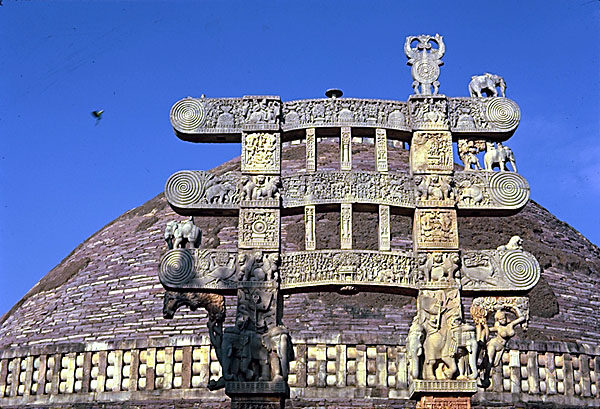
| Madhya Pradesh | |||||
| Bhopal | Amarkantak | Bandhavgarh | Bhedaghat | Bhojpur | Bhimbetka |
| Chitrakoot | Chanderi | Chattisgarh & Bastar | Gwalior | Indore | Jabalpur |
| Kanha | Khajuraho | Pachmarhi | Sanchi | Shivpuri | Ujjain |
SANCHI

Sanchi is known for its Stupas, monasteries, temples and pillars dating from the 3rd century B.C. to the 12th century A.D. The most famous of these monuments, the Sanchi Stupa 1, was originally built by the Mauryan Emperor Ashoka, the then governor of Ujjayini, whose wife Devi was the daughter of a merchant from adjacent Vidisha. Their son Mahindra and daughter Sanghamitra were born in Ujjayini and sent to Sri Lanka, where they converted the King, the Queen and their people to Buddhism.
Places to See
The Sanchi hill goes up in shelves with Stupa 2 situated on a lower shelf, Stupa 1, Stupa 3, the 5th century Gupta Temple No.17 and the 7th century temple No. 18 are on the intermediate shelf and a later monastery is on the crowning shelf. The balustrade surrounding Stupa 2, carved with aniconic representations of the Buddha, was added in the late 2nd century BC under the Satavahanas.
The adjacent Gupta temple no.17 was hailed by Sir John Marshall as one of the most rationally organized structures in Indian architecture. Though small, it was a herald of all the principles which went into the engineering of an Indian temple in the early medieval period. The Buddhas in the perambulatory surrounding Stupa 1 are not contemporary with the Stupa but belong to the Gupta period in the mid 5th century AD. The monastery and the temple with the tall pillars adjacent to Stupa 1 and the temple near the monastery on the crowning shelf illustrate the evolution of the architectural form after the 5th century Gupta temple.
Below the hill, the Archaeological Survey of India Museum houses some of the earliest known stone sculptures in Indian art from the 3rd to the 1st century BC.
The Four Gateways :
The Eastern Gateway

Depicts the young prince, Gautama leaving his father's palace on his journey towards enlightenment and the dream his mother had before his birth.
The Western Gateway

Depicts the seven incarnations of the Buddha.
The Northern Gateway

Crowned by a wheel-of-law, this depicts the miracles associated with the
Buddha as told in the jatakas.
The Southern Gateway
The birth of Gautama is revealed in a series of dramatically rich
carvings.
Great Stupa No. 1
The oldest stone structure in India. 36.5 mt in diameter and 16.4 mt high, with a massive hemispherical dome, the stupa stands in eternal majesty, the paved procession path around it worn smooth by centuries of pilgrims.
Stupa No. 2 The stupa stands at the very edge of the hill and its most striking feature is the stone balustrade that rings it.
Stupa No. 3 Situated close to the great stupa. The hemispherical dome is crowned, as a mark of its special religious significance, with an umbrella of polished stone. The relics of Sariputta and Mahamogallena, two of the Buddha's earliest disciples, were found in its inmost chamber.
The Ashoka Pillar

Lies close to the Southern gateway of the Great Stupa, and is one of the finest examples of the Ashokan pillar and is known for its aesthetic proportions and exquisite structural balance.
The Buddhist Vihara The sacred relics of the Satdhara Stupa, a few km away from Sanchi, have been enshrined in a glass casket on a platform in the inner sanctum of his modern monastery.
The Great Bowl Carved out of one block of stone, this mammoth bowl contained the food that was distributed among the monks of Sanchi.
The Gupta Temple In ruins now, this 5th century AD temple is one of the earliest known examples of temple architecture in India.
The Museum The Archaeological Survey of India maintains a site museum at Sanchi. Noteworthy antiquities on display include the lion capital of the Ashokan pillar and metal objects used by the monks, discovered during excavations at Sanchi.
Site Designed & Produced by Ashex Gething Morgan DotCom